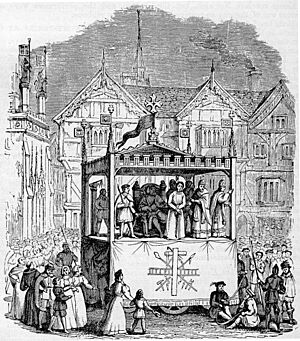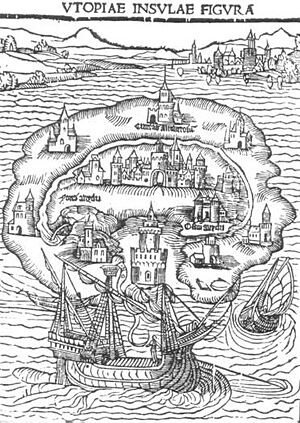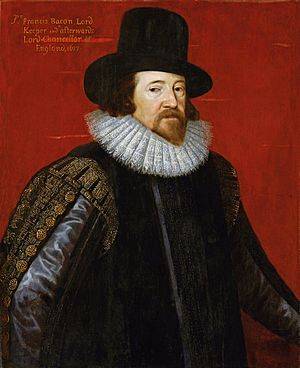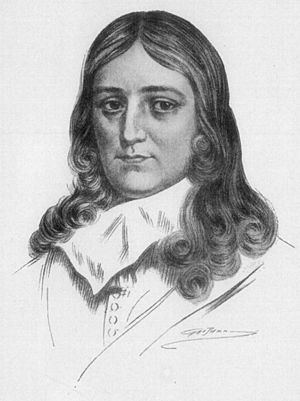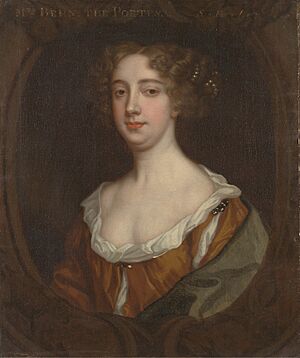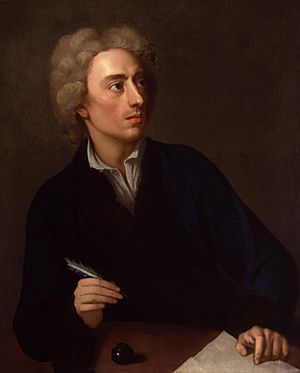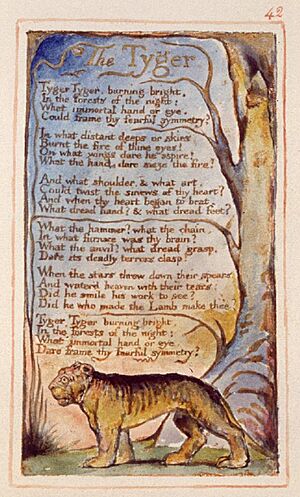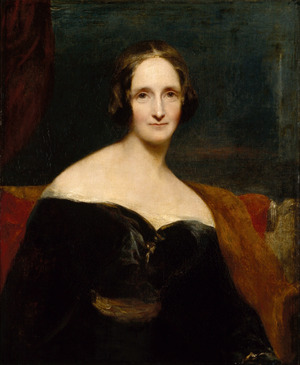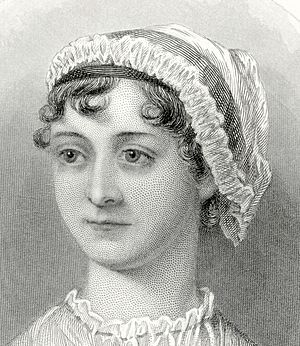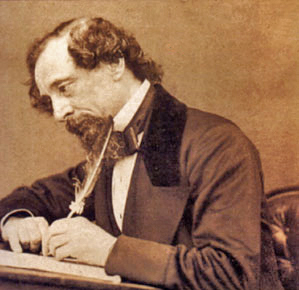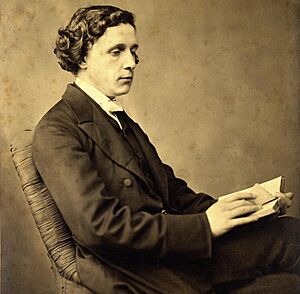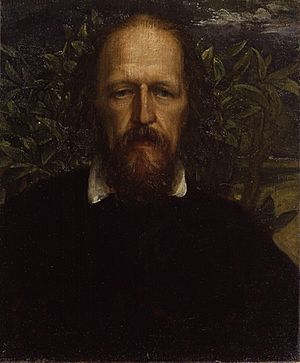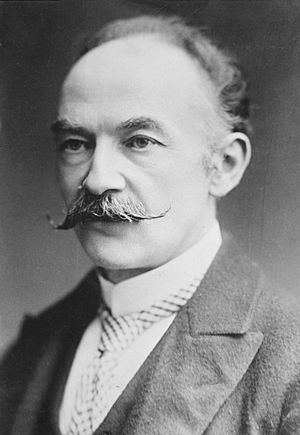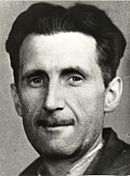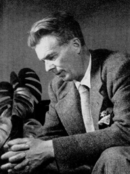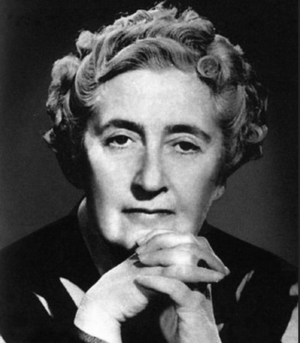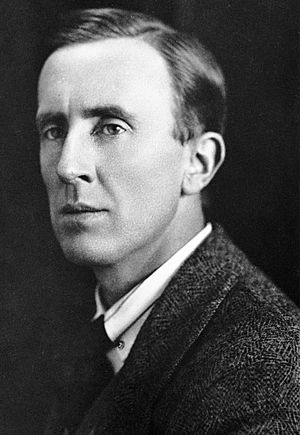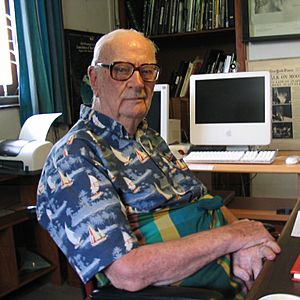British literature facts for kids
British literature is all the amazing stories, poems, and plays written in the United Kingdom (England, Scotland, Wales, and Northern Ireland), the Isle of Man, and the Channel Islands. This article will mostly talk about British literature written in the English language. We'll also look at some older writings in Old English, Latin, and Anglo-Norman that helped English literature grow. We'll briefly mention writers who used the Scots language, but you can find more about them in the Scottish literature articles.
Other languages spoken in Britain, like Cornish, Welsh, and Scottish Gaelic, also have their own rich literatures. You can learn more about them in articles like Literature in the other languages of Britain.
Writers from Ireland have greatly influenced literature in England and Scotland. Even though all of Ireland was once part of the United Kingdom of Great Britain and Ireland (from 1801 to 1922), it's sometimes debated whether to call Irish literature "British." For some, this includes works by authors from Northern Ireland.
Contents
- What is British Identity?
- Early British Literature: 449–1066
- Late Medieval Literature: 1066–1500
- The Renaissance: 1500–1660
- The Restoration: 1660–1700
- 18th-Century Literature
- Romanticism: 1798–1837
- Victorian Literature: 1837–1900
- 20th-Century Literature
- 21st-Century Literature
- Literary Institutions
- See also
What is British Identity?
The idea of being "British" has changed a lot over time. The island with England, Scotland, and Wales has been called Britain since the time of the Roman Empire. The English language began to form around AD 450, when Anglo-Saxons arrived. Before that, people mostly spoke different Celtic languages.
The parts of the United Kingdom joined at different times. Wales became part of England in the 1500s. Then, in 1707, England and Scotland joined to form the Kingdom of Great Britain. In 1801, this kingdom joined with Ireland to create the United Kingdom of Great Britain and Ireland. For a long time, Celtic languages were widely spoken in Scotland, Wales, Cornwall, and Ireland. These languages are still alive today, especially in parts of Wales.
Later, in 1921, the island of Ireland was divided. This means literature from the Republic of Ireland is not considered British, but literature from Northern Ireland can be seen as both Irish and British.
Since the 20th century, works written in English by Welsh writers, especially about Wales, have been recognized as a unique type of literature. This happened because modern Welsh-language literature was also developing at the same time.
Because Britain was a colonial power, English spread around the world. From the 1800s onwards, important English writers started appearing outside Britain and Ireland, including Nobel Prize winners.
Early British Literature: 449–1066
Other Languages in Early Britain
Even after the Romans left Britain in the early 5th century, Latin literature continued to be written. This included religious works and histories by writers like Bede (672–735) and Gildas (500–570).
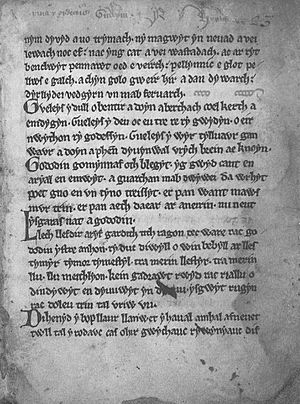
Many British people at that time spoke different Celtic languages. Important surviving works include Y Gododdin (a Welsh poem) and the Mabinogion (a collection of Welsh stories). From the 8th to the 15th centuries, Vikings and Norse settlers lived in parts of what is now Scotland. Some Old Norse poetry from this time still exists, like the Orkneyinga saga, which tells the history of the Orkney Islands.
Old English Literature: 658–1100

Old English literature, also called Anglo-Saxon literature, includes all the writings that survived from Anglo-Saxon England. This period runs from when the Saxons and other Germanic tribes settled in England around 450, until shortly after the Norman Conquest in 1066 (around 1100–1150). These works include epic poems, stories about saints, sermons, Bible translations, legal texts, histories, and riddles. About 400 manuscripts from this time still exist.
Storytelling was very important in early English culture, and most literary works were meant to be performed. Epic poems were very popular, and some, like Beowulf, are still known today. Beowulf is the most famous work in Old English and is considered England's national epic, even though it's set in Scandinavia.
Most Anglo-Saxon authors are unknown. Only twelve are named in old texts, and only four of those are definitely known for their English works: Cædmon, Bede, Alfred the Great, and Cynewulf. Cædmon is the earliest English poet whose name we know. His only surviving work is Cædmon's Hymn, likely from the late 7th century.
Historical records often included stories. A famous example is the Anglo-Saxon Chronicle. The poem Battle of Maldon also tells a historical event. It celebrates the real Battle of Maldon in 991, where Anglo-Saxons failed to stop a Viking invasion.
Ancient Greek and Roman ideas were not forgotten in Anglo-Saxon England. Several Old English poems are adaptations of old philosophical texts. The longest is King Alfred's (849–99) translation of Boethius' Consolation of Philosophy.
Late Medieval Literature: 1066–1500
The many languages spoken on the British Isles during the Middle Ages led to a rich and unique mix of artistic works.
Some works were still written in Latin. These include Gerald of Wales's 12th-century book about Wales, Itinerarium Cambriae. After the Norman Conquest in 1066, Anglo-Norman literature developed, bringing new literary styles from Europe, like the chanson de geste (epic poems about heroic deeds).
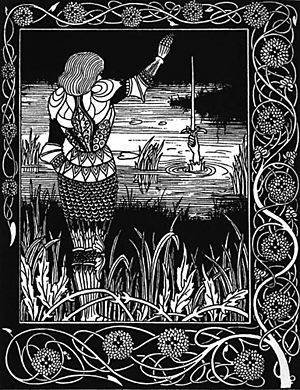
Geoffrey of Monmouth (around 1100 – 1155) was a key figure in British history writing and made the tales of King Arthur very popular. He is best known for his history book Historia Regum Britanniae (History of the Kings of Britain) from 1136. This book helped spread Celtic mythology to a wider audience. Wace (around 1110 – after 1174), who wrote in Norman-French, was the earliest known poet from Jersey. He also added to the Arthurian legend. At the end of the 12th century, Layamon adapted Wace's work in his poem Brut. This was the first English-language work to use the legends of King Arthur and the Knights of the Round Table. It was also the first history written in English since the Anglo-Saxon Chronicle.
Middle English Literature
Interest in King Arthur continued into the 15th century with Sir Thomas Malory's Le Morte d'Arthur (1485). This was a popular collection of French and English Arthurian romances. It was also one of the first books printed in England by William Caxton.
In the later medieval period, a new form of English developed, now called Middle English. This is the earliest form that modern readers can understand, though it's still a bit difficult. Middle English Bible translations, especially Wycliffe's Bible, helped make English a respected language for writing. Wycliffe's Bible refers to a group of Bible translations into Middle English made under the guidance of John Wycliffe between about 1382 and 1395.
Piers Plowman (written around 1360–1387) is a Middle English poem by William Langland. It's an allegory, meaning it uses characters and events to represent deeper ideas. It's written in alliterative verse (where words in a line often start with the same sound). Many experts consider Piers Plowman one of the great early works of English literature, along with Geoffrey Chaucer's Canterbury Tales and Sir Gawain and the Green Knight.
Sir Gawain and the Green Knight is a 14th-century Middle English chivalric romance poem. It's one of the most famous Arthurian stories. Drawing from Welsh, Irish, and English traditions, Sir Gawain emphasizes the importance of honor and chivalry. Three other poems, including the detailed poem Pearl, were found in the same manuscript as Sir Gawain and are believed to be by the same author.
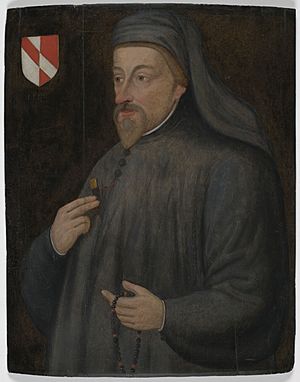
Geoffrey Chaucer (around 1343 – 1400) is widely seen as the greatest English poet of the Middle Ages. He was the first poet to be buried in Poet's Corner in Westminster Abbey. Chaucer is best known for The Canterbury Tales. This is a collection of stories, mostly in verse, told by a group of pilgrims traveling from Southwark to the shrine of Saint Thomas Becket at Canterbury Cathedral. Chaucer was very important in making Middle English a respected literary language, at a time when French and Latin were the main languages for writing in England.
The writer John Gower (around 1330 – 1408) shows how many languages were used for literature in the 14th century. Gower was a friend of Chaucer. He is known for three long poems: Mirroir de l'Omme (in Anglo-Norman), Vox Clamantis (in Latin), and Confessio Amantis (in Middle English). All three share common moral and political themes.
Women writers were also active. Marie de France wrote in the 12th century, and Julian of Norwich in the early 14th century. Julian's Revelations of Divine Love (around 1393) is thought to be the first published book written by a woman in English. Margery Kempe (around 1373 – after 1438) is known for The Book of Margery Kempe, which some consider the first autobiography in English.
Important Scottish writers from the 15th century include Robert Henryson, William Dunbar, Gavin Douglas, and David Lyndsay. Chaucer's works influenced many Scottish writers.
Medieval Drama
In the Middle Ages, plays in local languages likely grew out of religious performances in churches. Mystery plays were performed on cathedral porches or by traveling actors on special feast days. These plays, along with miracle plays and moralities, later developed into more complex forms of drama, like those seen on Elizabethan stages. Another type of medieval theater was the mummers' plays. These were early street plays, often linked to the Morris dance, focusing on folk tales like Saint George and the Dragon or Robin Hood. Actors traveled from town to town, performing these stories for money and food.
Mystery plays and miracle plays are among the earliest developed plays in medieval Europe. Mystery plays showed Bible stories in churches as living pictures with songs. They grew from the 10th to the 16th century, becoming very popular in the 15th century before professional theater took over.
Four complete or almost complete collections of English Bible plays from the late medieval period still exist. The most complete is the York cycle of forty-eight plays. They were performed in the city of York from the mid-14th century until 1569. Besides these Middle English plays, three plays in Cornish, known as the Ordinalia, have also survived.
Morality plays grew out of the religious mystery plays. They were a type of medieval and early Tudor theater that moved towards more secular (non-religious) themes. Morality plays are a kind of allegory where the main character meets personifications of different moral qualities who try to guide them towards a good life. These plays were most popular in Europe during the 15th and 16th centuries.
Everyman (around 1509–1519) is a famous late 15th-century English morality play. Like John Bunyan's Pilgrim's Progress (1678), Everyman explores the idea of Christian salvation using allegorical characters.
The Renaissance: 1500–1660
Renaissance styles and ideas took some time to reach England and Scotland. The Elizabethan era (1558–1603) is usually seen as the peak of the English Renaissance. However, many experts believe it started in the early 1500s during the reign of Henry VIII (1491–1547).
Italian literary influences arrived in Britain. The sonnet form was brought to English by Thomas Wyatt in the early 16th century. It was further developed by Henry Howard, Earl of Surrey (1516/1517–1547), who also introduced blank verse (poetry without rhyme) to England with his translation of Virgil's Aeneid around 1540.
The spread of printing changed how literature was shared across Britain and Ireland. The first book printed in English, William Caxton's translation of Recuyell of the Historyes of Troye, was printed abroad in 1473. The first printing press in England was set up in 1474.
Latin continued to be used for scholarly works long after the Reformation made local languages acceptable for religious services among the educated classes.
Utopia is a fictional work of political philosophy by Thomas More (1478–1535), published in 1516. The book, written in Latin, describes a fictional island society and its religious, social, and political customs.
Elizabethan Era: 1558–1603
Poetry
In the late 16th century, English poetry used complex language and many references to classical myths. Edmund Spenser (1555–99) wrote The Faerie Queene, an epic poem and a fantastical allegory celebrating the Tudor dynasty and Queen Elizabeth I. The works of Philip Sidney (1554–1586), a poet, courtier, and soldier, include Astrophel and Stella, The Defence of Poetry, and Arcadia. Poems meant to be sung, like those by Thomas Campion, became popular as printed literature became more common in homes.
Drama
During the reigns of Elizabeth I (1558–1603) and then James I (1603–25), London became a center for great poetry and drama. English playwrights were inspired by Italian plays. A notable group of Italian actors had settled in London. The linguist John Florio (1553–1625), whose father was Italian, was a royal language tutor and possibly a friend and influence on William Shakespeare. He brought much Italian language and culture to England. He also translated Michel de Montaigne's essays into English. The earliest Elizabethan plays include Gorboduc (1561) by Sackville and Thomas Norton, and Thomas Kyd's (1558–94) The Spanish Tragedy (1592). The Spanish Tragedy was very popular and influential, creating a new type of play in English theater: the revenge play. Jane Lumley (1537–1578) was the first person to translate Euripides into English. Her translation of Iphigeneia at Aulis is the first known play by a woman in English.
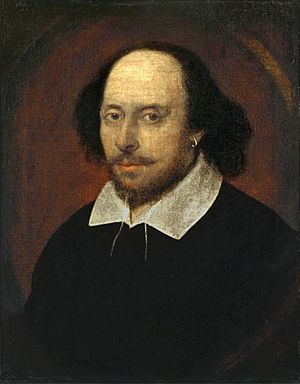
William Shakespeare (1564–1616) stands out in this period as a poet and playwright who is still considered unmatched. Shakespeare wrote plays in many styles, including histories, tragedies, comedies, and later romances (or tragicomedies). Works from the Elizabethan era include the comedy Twelfth Night, the tragedy Hamlet, and the history play Henry IV, Part 1.
Jacobean Period: 1603–1625
Drama
Shakespeare's career continued during the reign of King James I. In the early 17th century, he wrote his "problem plays" like Measure for Measure, and some of his most famous tragedies, including King Lear and Anthony and Cleopatra. The plots of Shakespeare's tragedies often turn on fatal mistakes or flaws that destroy the hero and those he loves. In his final period, Shakespeare wrote romances or tragicomedies, completing four major plays, including The Tempest. These plays are less dark than the tragedies and end with reconciliation and forgiveness.
Other important figures in Elizabethan and Jacobean theater include Christopher Marlowe (1564–1593), Thomas Dekker (around 1572 – 1632), John Fletcher (1579–1625), and Francis Beaumont (1584–1616). Marlowe's plays often focused on the moral struggles of a Renaissance man. His play Doctor Faustus (around 1592) is about a scientist and magician who sells his soul to the Devil. Beaumont and Fletcher are less known today, but they may have helped Shakespeare write some of his best plays and were popular at the time. Beaumont's comedy, The Knight of the Burning Pestle (1607), makes fun of the rising middle class.
After Shakespeare's death, the poet and dramatist Ben Jonson (1572–1637) became the leading literary figure of the Jacobean era. Jonson's plays often looked back to medieval ideas. His characters often showed the "theory of humours", a medical idea of the time, though Latin literature also influenced him. Jonson's major plays include Volpone (1605 or 1606) and Bartholomew Fair (1614).
A popular type of play in Jacobean times was the revenge play, made popular earlier by Thomas Kyd (1558–94) and then developed by John Webster (1578–1632) in the 17th century. Webster's most famous plays are The White Devil (1612) and The Duchess of Malfi (1613). Other revenge tragedies include The Changeling by Thomas Middleton and William Rowley.
Poetry
Shakespeare also made the English sonnet popular, changing Petrarch's original form. A collection of 154 sonnets, about themes like time, love, beauty, and death, was first published in 1609.
Besides Shakespeare, important poets of the early 17th century included the metaphysical poets John Donne (1572–1631) and George Herbert (1593–1633). Influenced by the European Baroque style, Donne's metaphysical poetry used unusual or "unpoetic" comparisons, like a compass or a mosquito, to create surprising effects.
George Chapman (1559–1634) was a successful playwright. He is mainly remembered for his 1616 translation of Homer's Iliad and Odyssey into English verse. This was the first complete translation of either poem into English and greatly influenced English literature.
Prose
The philosopher Francis Bacon (1561–1626) wrote the utopian novel New Atlantis and famously said, "Knowledge is Power." Francis Godwin's 1638 book The Man in the Moone tells of an imaginary trip to the moon and is now seen as the first science fiction work in English literature.
During the Protestant Reformation, translating religious texts and the Bible into local languages provided new literary styles. The Book of Common Prayer (1549) and the Authorised King James Version of the Bible were hugely influential. The King James Bible, one of the biggest translation projects in English history at the time, was started in 1604 and finished in 1611. It continued the tradition of Bible translation into English from the original languages, which began with William Tyndale. It became the standard Bible for the Church of England, and some consider it one of the greatest literary works ever.
Late Renaissance: 1625–1660
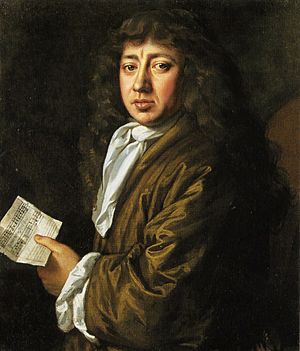
The metaphysical poets continued writing in this period. John Donne and George Herbert died after 1625, but a second group of metaphysical poets emerged: Andrew Marvell (1621–1678), Thomas Traherne (1636 or 1637–1674), and Henry Vaughan (1622–1695). Their style was clever, using conceits—unusual comparisons, like Marvell comparing the soul to a drop of dew, or Donne describing how absence affects lovers like a pair of compasses.
Another important group of poets at this time were the Cavalier poets. These writers supported King Charles I during the Wars of the Three Kingdoms (1639–51). (King Charles reigned from 1625 and was executed in 1649). The best-known Cavalier poets are Robert Herrick, Richard Lovelace, Thomas Carew, and Sir John Suckling. They were not a formal group but were all influenced by Ben Jonson. Most Cavalier poets were courtiers (people who attended the royal court), though Robert Herrick was not, his style fits the group. Cavalier works use allegory and classical references, and are influenced by Latin authors like Horace, Cicero, and Ovid.
John Milton (1608–74) is one of the greatest English poets. He wrote during a time of religious and political change. He is generally seen as the last major poet of the English Renaissance, though his main epic poems, like Paradise Lost (1667), were written later. His works include L'Allegro (1631), Il Penseroso (1634), Comus (a masque, 1638), and Lycidas (1638). His later major works are Paradise Regained (1671) and Samson Agonistes (1671). Milton's writings show his strong personal beliefs, his desire for freedom, and the urgent political issues of his time. He wrote in English, Latin, and Italian, and was famous during his lifetime. His famous work Areopagitica (1644), which spoke against censorship, is one of history's most powerful defenses of free speech.
The Restoration: 1660–1700
Drama
The return of the monarchy in 1660 brought a fresh start for literature. Theaters in England reopened after being closed during Oliver Cromwell's rule. Puritanism lost its power, and "Restoration comedy" became a recognized type of play. Restoration comedy refers to English comedies written and performed from 1660 to 1710. Also, for the first time, women were allowed to perform on stage.
The return of the monarchy in Ireland allowed Ogilby to reopen the first Theatre Royal in Dublin in 1662. In 1662, Katherine Philips went to Dublin, where she finished a translation of Pierre Corneille's Pompée. This play was very successful in 1663 and was printed in Dublin and London the same year. While other women had translated or written plays, her translation of Pompée was groundbreaking. It was the first rhymed version of a French tragedy in English and the first English play by a woman to be performed professionally. Aphra Behn was a very productive playwright and one of the first English professional female writers. Her biggest play success was The Rover (1677).
Poetry
Aphra Behn's character Willmore in The Rover and the clever, poetry-reciting Dorimant in George Etherege's The Man of Mode (1676) are seen as making fun of John Wilmot, 2nd Earl of Rochester (1647–1680). Rochester was an English poet and a witty figure at the Restoration court. His contemporary Andrew Marvell called him "the best English satirist." Rochester's poetry varied greatly in style and content. He was part of a group of gentlemen who wrote poetry easily and shared it in manuscripts rather than publishing it.
John Dryden (1631–1700) was an English poet, literary critic, translator, and playwright. He was so dominant in literature during the Restoration that the period is sometimes called the Age of Dryden. He made the heroic couplet (two rhyming lines) a standard form of English poetry. He used it in successful satires, religious works, fables, and plays. Dryden's greatest achievements were in satiric verse, like the mock-heroic MacFlecknoe (1682). W. H. Auden called him "the master of the middle style," which became a model for writers in the 18th century. The English literary world felt a great loss when he died, as shown by the many poems written in his honor. Alexander Pope (1688–1744) was greatly influenced by Dryden.
Although Ben Jonson had been poet laureate to James I in England, this was not a formal role then. The official title of Poet Laureate, as a royal office, was first given to John Dryden in 1670. This post then became a regular British institution.
Prose
Diarists John Evelyn (1620–1706) and Samuel Pepys (1633–1703) wrote about daily life in London and the culture of their time. Their works are very important sources for understanding the Restoration period in England. They provide firsthand accounts of major events, like the Great Plague of London (1644–5) and the Great Fire of London (1666).
The publication of The Pilgrim's Progress (Part I: 1678; Part II: 1684) made the Puritan preacher John Bunyan (1628–88) a famous writer. Bunyan's The Pilgrim's Progress is an allegory about personal salvation and a guide to Christian life. Bunyan writes about how a person can overcome temptations that threaten their spiritual well-being. The book is written in a simple narrative style and shows influences from both drama and biography, while also being part of the grand allegorical tradition found in Edmund Spenser's work.
18th-Century Literature
The Augustan Age: 1701–1750
The late 17th and early 18th centuries (1689–1750) in English literature are known as the Augustan Age. Writers at this time greatly admired Roman writers and copied their works. They often compared their own time to the age of the Roman emperor Augustus. Some major writers from this period were the Anglo-Irish writer Jonathan Swift (1667–1745), William Congreve (1670–1729), Joseph Addison (1672–1719), Richard Steele (1672–1729), Alexander Pope (1688–1744), Henry Fielding (1707–54), and Samuel Johnson (1709–84).
1707: The Birth of Britain
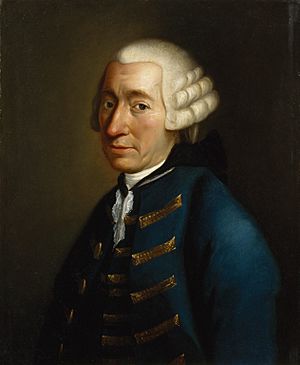
The joining of the Parliaments of Scotland and England in 1707 to form the Kingdom of Great Britain had little effect on English literature or how English writers saw their national identity. The situation in Scotland was different. The desire to keep a Scottish cultural identity while benefiting from the English literary market led Scottish writers to "invent British literature." English writers often assumed "Britain" just meant a bigger England. Scottish writers were more aware of the new state as a mix of cultures. James Thomson's "Rule Britannia!" is an example of a Scottish writer promoting this new British identity.
With the idea of British literature came the first British novels. These were different from the English novels of the 18th century, which focused only on England. Tobias Smollett (1721–71) was a Scottish pioneer of the British novel. He explored the prejudices within the new social structure through funny picaresque novels (stories about a clever, often mischievous, hero). His The Adventures of Roderick Random (1748) is the first major English novel with a Scotsman as the hero. It was published only two years after the Battle of Culloden and showed different voices in the story challenging anti-Scottish feelings. The Expedition of Humphry Clinker (1771) brings together characters from different parts of Britain to question how cultural and language differences could fit into the new British identity. This book influenced Charles Dickens.
Prose, Including the Novel
In prose, the early part of this period was dominated by the development of the English essay. Joseph Addison and Richard Steele's The Spectator created the style of the British periodical essay. It presented the idea of a detached observer of human life who could think about the world without pushing for specific changes. However, this was also when the English novel, which first appeared in the Restoration, became a major art form. Daniel Defoe switched from journalism to writing fictional criminal lives with Roxana and Moll Flanders.
The English novel is generally thought to have begun with Daniel Defoe's Robinson Crusoe (1719) and Moll Flanders (1722). However, John Bunyan's The Pilgrim's Progress (1678) and Aphra Behn's Oroonoko (1688) are also considered early examples. Other major 18th-century British novelists include Samuel Richardson (1689–1761), who wrote the epistolary novels (novels told through letters) Pamela, or Virtue Rewarded (1740) and Clarissa (1747–48). Henry Fielding (1707–54) wrote Joseph Andrews (1742) and The History of Tom Jones, a Foundling (1749).
While Addison and Steele were important for one type of prose, Jonathan Swift, author of the satire Gulliver's Travels, was important for another. In A Modest Proposal and the Drapier Letters, Swift reluctantly defended the Irish people from the harm caused by colonialism. This led to protests and arrests, but Swift, who didn't like Irish Catholics, was angered by the abuses he saw.
The English artist William Hogarth (1697–1764) is known for pioneering Western sequential art (like comic strips). His work ranged from realistic portraits to comic-like series of pictures called "modern moral subjects." Much of his work made fun of contemporary politics and customs.
Drama
Although Irish theater history began as early as 1601, the earliest notable Irish playwrights were William Congreve (1670–1729), known for his Restoration comedies like The Way of the World (1700), and George Farquhar (1677–1707), who wrote The Recruiting Officer (1706).
Anglo-Irish drama in the 18th century also includes works by Charles Macklin (1699–1797) and Arthur Murphy (1727–1805).
The era of Augustan drama ended with censorship from the Licensing Act 1737. After 1737, authors with strong political or philosophical messages no longer turned to the stage first. Novels began to have dramatic structures involving ordinary people, as the stage was closed off for serious authors. Before the 1737 Act, theater was the first choice for most clever writers. After it, the novel became more important.
Poetry
The most outstanding poet of this age is Alexander Pope (1688–1744). His major works include translations of the Iliad (1715–20) and the Odyssey (1725–26), and The Dunciad (1728; 1743). After his death, Pope's reputation has been constantly re-evaluated. His complex style, strict rhythm, and sometimes harsh satire were disliked by the Romantic poets. It wasn't until the 1930s that his reputation was revived. Pope is now considered the most important poetic voice of his century, known for his elegant rhythm, sharp wit, and strong moral message. The Rape of the Lock and The Dunciad are masterpieces of the mock-epic genre (poems that use epic style to make fun of trivial subjects).
During this time, poet James Thomson (1700–48) wrote his thoughtful poem The Seasons (1728–30). Edward Young (1681–1765) wrote his poem Night-Thoughts (1742).
The Roots of Romanticism: 1750–1798
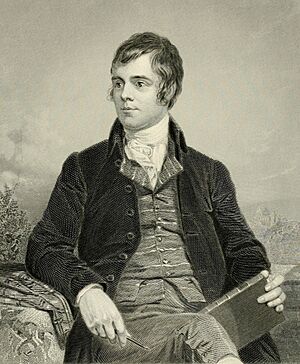
The second half of the 18th century is sometimes called the "Age of Johnson." Samuel Johnson (1709–1784), often called Dr. Johnson, was an English author who made lasting contributions to English literature as a poet, essayist, moralist, literary critic, biographer, editor, and lexicographer (dictionary maker). Johnson has been described as "arguably the most distinguished man of letters in English history." After nine years of work, Johnson's A Dictionary of the English Language was published in 1755. It had a huge impact on Modern English and is described as "one of the greatest single achievements of scholarship." Through works like the Dictionary, his edition of Shakespeare, and his Lives of the Poets, he helped create what we now call English Literature.
This period saw the rise of three major Irish authors: Oliver Goldsmith (1728–1774), Richard Brinsley Sheridan (1751–1816), and Laurence Sterne (1713–68). Goldsmith moved to London in 1756. He published the novel The Vicar of Wakefield (1766), a pastoral poem The Deserted Village (1770), and two plays, The Good-Natur'd Man (1768) and She Stoops to Conquer (1773). Sheridan was born in Dublin, but his family moved to England in the 1750s. His first play, The Rivals (1775), was a huge success. He became the most important London playwright of the late 18th century with plays like The School for Scandal and The Critic. Sterne published his famous novel Tristram Shandy in parts between 1759 and 1767.
The sentimental novel (or novel of sensibility) was a type of novel that developed in the second half of the 18th century. Famous sentimental novels in English include Samuel Richardson's Pamela, or Virtue Rewarded (1740), Oliver Goldsmith's The Vicar of Wakefield (1766), and Laurence Sterne's Tristram Shandy (1759–67).
Another novel type also developed. In 1778, Frances Burney (1752–1840) wrote Evelina, one of the first novels of manners (which describe the customs and behaviors of a social class). Jane Austen enjoyed and admired Fanny Burney's novels.
The graveyard poets were a group of English poets writing in the 1740s and later. Their works often focused on sad thoughts about death, using images of "skulls and coffins, epitaphs and worms" in graveyards. Later poets in this group added a sense of the 'sublime' (a feeling of awe and wonder) and an interest in old English poetic forms and folk poetry. They are often seen as early influences on the Gothic genre. These poets include Thomas Gray (1716–71), known for Elegy Written in a Country Churchyard (1751).
Other early influences on Romanticism include the poets James Thomson (1700–48) and James Macpherson (1736–96), the Gothic novel, and the novel of sensibility.
Gothic fiction also foreshadowed Romanticism, with works like Horace Walpole's 1764 novel The Castle of Otranto. The Gothic fiction genre mixes elements of horror and romance. A pioneering Gothic novelist was Ann Radcliffe, author of The Mysteries of Udolpho (1794). The Monk (1796), by Matthew Lewis, is another important early work in both the Gothic and horror genres.
James Macpherson (1736–96) was the first Scottish poet to become famous internationally. He claimed to have found poems by the ancient bard Ossian and published translations that became very popular worldwide. They were seen as a Celtic version of the great Classical epic poems. Both Robert Burns (1759–96) and Walter Scott (1771–1832) were greatly influenced by the Ossian cycle.
Robert Burns (1759–1796) was a pioneer of the Romantic movement. After his death, he became a cultural icon in Scotland. Some of Burns's poems and songs that are still well-known around the world include "Auld Lang Syne," "A Red, Red Rose," "A Man's A Man for A' That," "To a Mouse," "Tam o' Shanter," and "Ae Fond Kiss".
Romanticism: 1798–1837
Romanticism was an artistic, literary, and intellectual movement that began in Europe in the late 18th century. Different dates are given for the Romantic period in British literature. Here, we'll say it started with the publishing of Lyrical Ballads in 1798 and ended with the crowning of Queen Victoria in 1837. However, writers of this period didn't call themselves "Romantics." The term was first used by critics in the Victorian period.
The Romantic period was a time of big social change in England. The countryside became less populated, and industrial cities grew rapidly and became overcrowded between about 1785 and 1830. This movement of people was due to two things: the British Agricultural Revolution, which involved enclosing land and driving workers off it, and the Industrial Revolution, which offered jobs in factories run by steam power. Romanticism can be seen partly as a reaction to the Industrial Revolution. It was also a rebellion against the social and political rules of the Age of Enlightenment and against the scientific way of looking at nature. The French Revolution was a very important influence on the political ideas of many Romantic poets.
Nature is often very important in the poetry of this period. Romantics, especially Wordsworth, are often called 'nature poets'. However, the longer Romantic 'nature poems' have a broader focus because they are usually thoughts about "an emotional problem or personal crisis."
Romantic Poetry
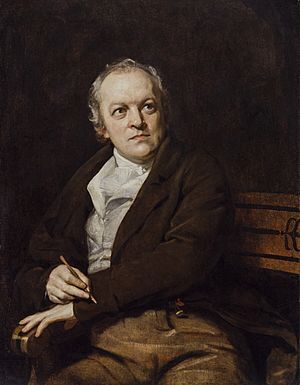
The poet, painter, and printmaker William Blake (1757–1827) was one of the first English Romantic poets. He was largely separate from the main literary trends of his time and was not widely recognized during his life. However, he is now considered a key figure in the history of both poetry and visual arts of the Romantic Age. His most important works include Songs of Innocence (1789) and Songs of Experience (1794), and complex "prophecies" like Visions of the Daughters of Albion (1793) and The First Book of Urizen (1794).
After Blake, among the earliest Romantics were the Lake Poets. This was a small group of friends, including William Wordsworth (1770–1850), Samuel Taylor Coleridge (1772–1834), Robert Southey (1774–1843), and journalist Thomas De Quincey (1785–1859). However, at the time, Walter Scott (1771–1832) was the most famous poet. Scott became instantly successful with his long narrative poem The Lay of the Last Minstrel in 1805, followed by the epic poem Marmion in 1808. Both were set in Scotland's distant past.
The early Romantic Poets brought new emotional depth and self-reflection to poetry. Their emergence is marked by the first romantic manifesto in English literature, the "Preface" to Lyrical Ballads (1798). The poems in Lyrical Ballads were mostly by Wordsworth, though Coleridge contributed the long "Rime of the Ancient Mariner". Among Wordsworth's most important poems are "Michael", "Lines Composed a Few Miles Above Tintern Abbey", "Resolution and Independence", "Ode: Intimations of Immortality from Recollections of Early Childhood", and the long, autobiographical epic The Prelude.
Robert Southey (1774–1843) was another of the "Lake Poets" and Poet Laureate for 30 years (1813–1843). Although his fame has been overshadowed by his friends William Wordsworth and Samuel Taylor Coleridge.
Second Generation of Romantic Poets
The second generation of Romantic poets includes Lord Byron (1788–1824), Percy Bysshe Shelley (1792–1822), and John Keats (1795–1821). Byron was still influenced by 18th-century satirists and was perhaps the least "romantic" of the three. He preferred the clever wit of Alexander Pope to what he called the "wrong poetical system" of his Romantic friends.
Although John Keats shared Byron and Shelley's radical political views, "his best poetry is not political." It is especially known for its beautiful sounds and images, and its focus on physical beauty and the fleeting nature of life. His most famous works include "The Eve of St Agnes", "La Belle Dame sans Merci", "Ode to a Nightingale", and "To Autumn".
Percy Shelley, known for his radical politics and his connections to figures like Byron and Mary Shelley (daughter of thinkers William Godwin and Mary Wollstonecraft), was the third major romantic poet of the second generation. Generally seen as one of the finest lyric poets in English, Shelley is perhaps best known for poems like Ozymandias, Ode to the West Wind, To a Skylark, and Adonaïs, a poem written after Keats's death. Mary Shelley (1797–1851) is remembered as the author of Frankenstein (1818), an important Gothic novel and an early example of science fiction.
Romanticism and the Novel
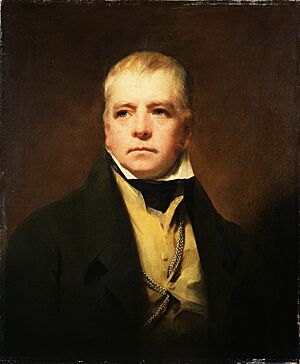
Major novelists in this period were Jane Austen (1775–1817) and the Scotsman Walter Scott (1771–1832). Different kinds of Gothic fiction also thrived. Austen's works make fun of the sentimental novels of the late 18th century and are part of the shift towards 19th-century realism. Austen's works include Pride and Prejudice (1813), Sense and Sensibility (1811), Mansfield Park (1814), Emma (1815), and Persuasion (1818).
The most important British novelist at the start of the 19th century was Sir Walter Scott. He was not only a very successful British novelist but also "the greatest single influence on fiction in the 19th century." Scott's novel writing career began in 1814 with Waverley, often called the first historical novel. This was followed by Ivanhoe. The Waverley Novels, including The Antiquary, Old Mortality, and The Heart of Midlothian, focus on Scottish history and are now generally seen as Scott's best works.
Victorian Literature: 1837–1900
Victorian Fiction
The Novel
It was during the Victorian era (1837–1900) that the novel became the most important type of literature in English. Women played a big part in this rise in popularity, both as authors and as readers. Publishing fiction in monthly parts helped this popularity grow, thanks to more people being able to read, new printing technology, and better ways to distribute books. Circulating libraries, where books could be borrowed for a yearly fee, also helped make novels more popular.
Charles Dickens (1812–70) appeared on the literary scene in the late 1830s and quickly became perhaps the most famous novelist in British literature history. Dickens strongly criticized different parts of society, including the workhouse in Oliver Twist and the failures of the legal system in Bleak House. In recent years, Dickens has been most admired for his later novels, such as Dombey and Son (1846–48), Bleak House (1852–53), Little Dorrit (1855–57), Great Expectations (1860–61), and Our Mutual Friend (1864–65).
An early rival to Dickens was William Makepeace Thackeray (1811–63). During the Victorian period, he was second only to Dickens in fame. However, he is read much less now and is known almost entirely for Vanity Fair (1847).
The Brontë sisters—Emily, Charlotte, and Anne—were other important novelists in the 1840s and 1850s. Their novels caused a stir when first published but were later accepted as classics. Charlotte Brontë's (1816–55) Jane Eyre was groundbreaking because it was written from a very personal female point of view. Emily Brontë's (1818–48) novel was Wuthering Heights. The third Brontë novel of 1847 was Anne Brontë's (1820–49) Agnes Grey, which describes the lonely life of a governess.
Elizabeth Gaskell (1810–65) was also a successful writer. Her novel North and South compares life in the industrial north of England with the wealthier south.
Anthony Trollope (1815–82) was one of the most successful and respected English novelists of the Victorian era. Some of his most loved works are set in the imaginary county of Barsetshire, including The Warden (1855) and Barchester Towers (1857). Trollope's novels show the lives of the landowning and professional classes in early Victorian England.
George Eliot (Mary Ann Evans, 1819–80) was a major novelist of the mid-Victorian period. Her works, especially Middlemarch (1871–72), are important examples of literary realism. They are admired for combining detailed Victorian writing with a broad intellectual scope, which has led to comparisons with Tolstoy.
George Meredith (1828–1909) is best remembered for his novels The Ordeal of Richard Feverel (1859) and The Egoist (1879). His reputation was very high into the 20th century but then declined.
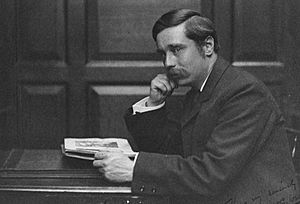
An interest in rural life and the changing social and economic situation of the countryside is seen in the novels of Thomas Hardy (1840–1928). A Victorian realist, like George Eliot, he was also influenced by Romanticism, especially by William Wordsworth. He became famous as the author of novels such as Far from the Madding Crowd (1874), The Mayor of Casterbridge (1886), Tess of the d'Urbervilles (1891), and Jude the Obscure (1895).
Another important late 19th-century novelist is George Gissing (1857–1903), who published 23 novels between 1880 and 1903. His best-known novel is New Grub Street (1891). Also in the late 1890s, the first novel by Polish-born immigrant Joseph Conrad (1857–1924) was published. Conrad was an important early influence on modernist literature. His Heart of Darkness was published in 1899.
The Short Story
Early European examples of short stories were published separately between 1790 and 1810. However, the first true collections of short stories appeared between 1810 and 1830 in several countries around the same time. The first short stories in the United Kingdom were gothic tales like Richard Cumberland's "The Poisoner of Montremos" (1791). Major novelists like Walter Scott and Charles Dickens also wrote some short stories.
Genre Fiction
Important developments happened in genre fiction during this era.
Adventure novels were popular. These included Sir John Barrow's 1831 account of the Mutiny on the Bounty. The Lost World literary genre was inspired by real stories of archaeological discoveries by explorers. Henry Rider Haggard wrote one of the earliest examples, King Solomon's Mines, in 1885. Contemporary European politics influenced Anthony Hope's exciting Ruritanian adventure novels like The Prisoner of Zenda (1894). Robert Louis Stevenson (1850–94) also wrote works in this genre, including Kidnapped (1886), a historical novel set after the Jacobite rising of 1745, and Treasure Island (1883), a classic pirate adventure.
Wilkie Collins's novel The Moonstone (1868), told through letters, is generally considered the first detective novel in English. Soon after, Arthur Conan Doyle began his Sherlock Holmes series about a London-based "consulting detective." Doyle wrote four novels and fifty-six short stories featuring Holmes, from 1880 to 1907, with a final case in 1914.
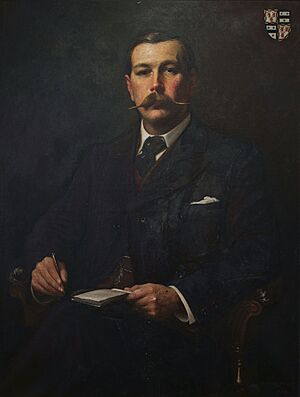
H. G. Wells's (1866–1946) writing career began in the 1890s with science fiction novels like The War of the Worlds (1898), which describes an invasion of late Victorian England by Martians. Wells, along with Frenchman Jules Verne (1828–1905), is a major figure in the development of the science fiction genre.
The history of modern fantasy is generally said to begin with George MacDonald, the influential author of The Princess and the Goblin and Phantastes (1858). William Morris was a popular English poet who also wrote several fantasy novels in the late 19th century. The vampire genre began with John William Polidori's "The Vampyre" (1819). This short story was inspired by Lord Byron. Irish writer Bram Stoker wrote the important horror work Dracula (1897), featuring the vampire Count Dracula.
Penny dreadful publications were an alternative to mainstream works. They were aimed at working-class teenagers and introduced characters like the infamous Sweeney Todd. The top ghost story writer of the 19th century was the Irish writer Sheridan Le Fanu.
Children's Literature
Literature for children developed as a separate type of writing during the Victorian era. Some works became famous worldwide, such as Lewis Carroll's Alice's Adventures in Wonderland (1865). At the end of the 19th century, author and illustrator Beatrix Potter became known for her children's books with animal characters, including The Tale of Peter Rabbit (1902). In the later years of the 19th century, early picture books were illustrated books of poems and short stories by illustrators Randolph Caldecott, Walter Crane, and Kate Greenaway. These books had more pictures than words, and many pictures were in color. Vice Versa (1882) by F. Anstey tells of a father and son who switch bodies. Body swaps have been a popular theme in various media since the book was published.
Victorian Poetry
The leading poets during the Victorian period were Alfred, Lord Tennyson (1809–1892), Robert Browning (1812–89), Elizabeth Barrett Browning (1806–61), and Matthew Arnold (1822–88). The poetry of this period was heavily influenced by the Romantics but also went in its own directions. Especially notable was the development of the dramatic monologue, a form used by many poets but perfected by Browning.
Tennyson was Poet Laureate of the United Kingdom for much of Queen Victoria's reign. T. S. Eliot described him as "the greatest master of metrics as well as melancholia" and as having "the finest ear of any English poet since John Milton".
While Elizabeth Barrett Browning was Robert Browning's wife, she had become a major poet before she met him. Her most famous work is the collection of 44 sonnets "Sonnets from the Portuguese" published in Poems (1850). Matthew Arnold's reputation as a poet has declined, and he is now best remembered for his critical works, like Culture and Anarchy (1869), and his 1867 poem "Dover Beach".
Dante Gabriel Rossetti (1828–1882) was a poet, illustrator, painter, and translator. He founded the Pre-Raphaelite Brotherhood in 1848 with William Holman Hunt and John Everett Millais. He later inspired a second group of artists and writers, most notably William Morris and Edward Burne-Jones.
George Meredith (1828–1909) is remembered for his innovative collection of poems Modern Love (1862).
In the second half of the century, English poets became interested in French Symbolism. Two groups of poets emerged in the 1890s: the Yellow Book poets, who followed the ideas of Aestheticism (art for art's sake), including Algernon Charles Swinburne, Oscar Wilde, and Arthur Symons; and the Rhymers' Club group, which included Ernest Dowson, Lionel Johnson, and Irishman William Butler Yeats. Yeats went on to become an important modernist in the 20th century. Also in the 1890s, A. E. Housman (1859–1936) published A Shropshire Lad at his own expense. The poems' sad portrayal of doomed youth in the English countryside, with simple language and unique images, strongly appealed to people in the late Victorian and Edwardian eras.
The nonsense verse of Edward Lear, along with the novels and poems of Lewis Carroll, is seen as an early influence on surrealism. In 1846, Lear published A Book of Nonsense, a collection of limericks that helped make the form popular.
Writers of funny poems included the dramatist, librettist, poet, and illustrator W. S. Gilbert (1836–1911). He is best known for his fourteen comic operas created with composer Sir Arthur Sullivan. Famous examples include H.M.S. Pinafore, The Pirates of Penzance, and The Mikado, one of the most frequently performed musical theater works.
Victorian Drama
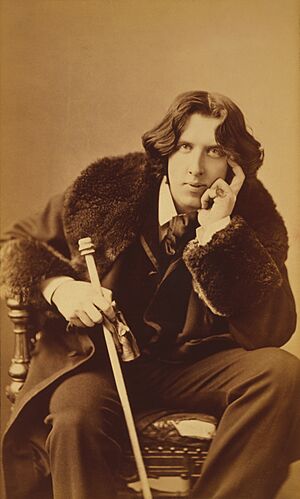
For much of the first half of the 19th century, plays in London and provincial theaters were limited by a licensing system to certain "Patent" theater companies. Other theaters could only perform musical shows. The Theatres Act 1843 removed this monopoly on drama.
Irish playwright Dion Boucicault (1820–90) was a very popular writer of comedies. He found success on the London stage with works like London Assurance (1841) in the mid-19th century. However, drama didn't become a major genre in the 19th century until its end. Then, the main figures were also Irish-born. In the last decade of the century, important playwrights emerged, including George Bernard Shaw (1856–1950), known for Arms and the Man (1894), and Oscar Wilde (1854–1900), known for The Importance of Being Earnest (1895). Both of these Irish writers lived mostly in England and wrote in English, except for some works in French by Wilde.
20th-Century Literature
The year 1922 marked a big change between Great Britain and Ireland. The Irish Free State was set up in most of Ireland, while Northern Ireland remained part of the United Kingdom. This separation raises questions about whether Irish writing before 1922 should be seen as colonial literature. There are also debates about whether literature from Northern Ireland is Irish or British. Nationalist movements in Britain, especially in Wales and Scotland, also greatly influenced writers in the 20th and 21st centuries.
Modernism and Cultural Revivals: 1901–1945
From around 1910, the Modernist movement began to influence British literature. While Victorian writers often tried to please mainstream tastes, 20th-century writers often felt disconnected from it. They responded by writing more intellectually challenging works or by pushing the boundaries of what was considered acceptable.
Edwardian Fiction
The short but influential Edwardian era began with the death of Queen Victoria in 1901 and lasted until World War I. During this time, the world met the charming animal characters of Beatrix Potter and the always-young adventures of Peter Pan (J. M. Barrie). A. A. Milne also began writing then, but his beloved Winnie-the-Pooh wouldn't be published until 1926. Rudyard Kipling's Just So Stories For Little Children (1902) was a successful follow-up to his earlier adventures with Mowgli in The Jungle Book (1894).
Other great novels of the time had an optimistic but critical tone, including E. M. Forster's A Room with a View (1908). In this book, Forster makes fun of the classism and xenophobia (dislike of foreigners) of Victorian England. He used his own travel experiences to question the "deep-seated biases" of the previous century. The Women's Suffrage Movement was also gaining strength, and fiction reflected these ideas. More than ever, fictional women were main characters, and they often crossed social and geographical boundaries through marriage or seeking knowledge.
Joseph Conrad's Heart of Darkness (1899) is another early but important example of the changing times during King Edward VII's reign. While Conrad's portrayal of local Africans is often criticized as dehumanizing, others argue that this view belongs to the fictional narrator, and Conrad himself aimed to show the unclear and dark sides of all societies.
First World War Literature
The experiences of the First World War were reflected in the works of war poets such as Wilfred Owen, Rupert Brooke, Isaac Rosenberg, Robert Graves, and Siegfried Sassoon. In Parenthesis, an epic poem by David Jones first published in 1937, is a notable work about the war. It was influenced by Welsh traditions, even though Jones was born in England. In non-fiction, T. E. Lawrence's (Lawrence of Arabia) autobiography Seven Pillars of Wisdom about the Arab Revolt is important.
Poetry: 1901–1945
Two Victorian poets who published little in the 19th century, Thomas Hardy (1840–1928) and Gerard Manley Hopkins (1844–89), are now seen as major poets. While Hardy first became famous in the late 19th century with novels, he also wrote poetry throughout his career. However, he didn't publish his first collection until 1898, so he is often considered a 20th-century poet. Gerard Manley Hopkins's Poems were published after his death in 1918 by Robert Bridges.
Free verse (poetry without regular rhyme or meter) and other new styles became prominent in this era, especially associated with T. S. Eliot and Ezra Pound. T. S. Eliot (1888–1965) was born American but moved to England in 1914. He was "arguably the most important English-language poet of the 20th century." He wrote some of the best-known poems in English, including "The Waste Land" (1922) and Four Quartets (1935–1942).
The Georgian poets like Rupert Brooke, Walter de la Mare (1873–1956), and John Masefield (1878–1967, Poet Laureate from 1930) kept a more traditional approach to poetry. They combined romanticism, sentimentality, and a love of pleasure. Edward Thomas (1878–1917) is sometimes seen as another Georgian poet.
In the 1930s, the Auden Group, also called the Thirties poets, was an important group of politically left-wing writers. It included W. H. Auden (1907–73) and two Anglo-Irish writers, Cecil Day-Lewis (1904–72) and Louis MacNeice (1907–1963). Auden was a major poet who influenced later poets, much like W. B. Yeats and T. S. Eliot influenced earlier generations.
Keith Douglas (1920–1944) was known for his war poetry during World War II and his dry memoir of the Western Desert Campaign, Alamein to Zem Zem. He was killed in action during the invasion of Normandy. Alun Lewis (1915–1944), born in South Wales, was one of the best-known English-language poets of the war. The Second World War has remained a theme in British literature.
Modernist Novel

While modernism became an important literary movement in the early decades of the new century, there were also many great writers who, like Thomas Hardy, were not modernists. Novelists include: Rudyard Kipling (1865–1936), who was also a successful poet; H. G. Wells (1866–1946); John Galsworthy (1867–1933), who won the Nobel Prize in Literature in 1932, and whose novels include The Forsyte Saga (1906–21); Arnold Bennett (1867–1931), author of The Old Wives' Tale (1908); G. K. Chesterton (1874–1936); and E.M. Forster (1879–1970). The most popular British writer of the early 20th century was arguably Rudyard Kipling, a very versatile writer of novels, short stories, and poems. He is still the youngest person to receive the Nobel Prize for Literature (1907).
H. G. Wells was a very productive author, now best known for his science fiction. His most notable science fiction works include The War of the Worlds and The Time Machine, written in the 1890s. Forster's A Passage to India (1924) showed challenges to imperialism. His earlier works like A Room with a View (1908) and Howards End (1910) looked at the strict rules and hypocrisy of Edwardian society in England.
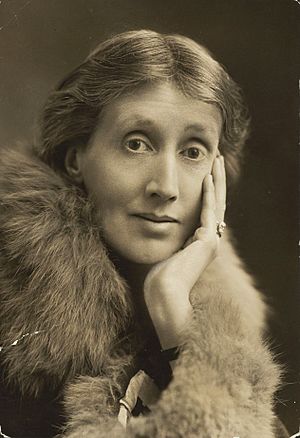
Writing in the 1920s and 1930s, Virginia Woolf was an influential feminist and a major innovator in style, known for the stream-of-consciousness technique (showing a character's thoughts as they flow). Her novels include Mrs Dalloway (1925) and The Waves (1931). Her book A Room of One's Own (1929) contains her famous statement: "A woman must have money and a room of her own if she is to write fiction." Woolf and E. M. Forster were members of the Bloomsbury Group, a very influential group of English writers, thinkers, philosophers, and artists.
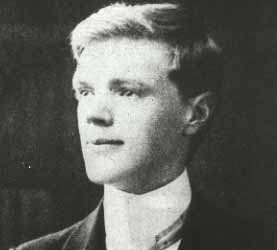
Other early modernists were Dorothy Richardson (1873–1957), whose novel Pointed Roof (1915) is an early example of the stream of consciousness technique. D. H. Lawrence (1885–1930) wrote with understanding about the social lives of the lower and middle classes, and the personal lives of those who couldn't fit into the social norms of his time. Sons and Lovers (1913) is widely seen as his earliest masterpiece. This was followed by The Rainbow (1915) and its sequel Women in Love (published 1920).
An important development, starting in the 1930s and 1940s, was a tradition of working-class novels actually written by authors from a working-class background.
An essayist and novelist, George Orwell's works are important social and political commentaries of the 20th century. He dealt with issues like poverty in The Road to Wigan Pier (1937). In the 1940s, his satires of totalitarianism included Animal Farm (1945). Malcolm Lowry published in the 1930s, but is best known for Under the Volcano (1947). Evelyn Waugh made fun of the "bright young things" (wealthy, fashionable young people) of the 1920s and 1930s, especially in A Handful of Dust and Decline and Fall. His novel Brideshead Revisited (1945) has a religious basis, looking at the effect of divine grace on its main characters. Aldous Huxley (1894–1963) published his famous dystopia (a fictional bad place) Brave New World in 1932. In 1938, Graham Greene's (1904–91) first major novel Brighton Rock was published.
Late Modernism: 1946–2000
Some people think modernism ended around 1939. However, many modernists were still living and publishing in the 1950s and 1960s, including T. S. Eliot, Dorothy Richardson, and John Cowper Powys. Also, Northumberland poet Basil Bunting, born in 1901, published little until Briggflatts in 1965.
Novel
In 1947, Malcolm Lowry published Under the Volcano. George Orwell's satire of totalitarianism, Nineteen Eighty-Four, was published in 1949. Orwell's works are important social and political commentaries of the 20th century. Evelyn Waugh's Second World War trilogy Sword of Honour (1952–61) was published in this period.
Graham Greene's works span from the 1930s to the 1980s. He converted to Catholicism, and his novels explore the complex moral and political issues of the modern world. Other novelists writing in the 1950s and later include: Anthony Powell, known for A Dance to the Music of Time; Nobel Prize winner William Golding; Anglo-Irish philosopher Iris Murdoch; and Scottish novelist Muriel Spark, known for The Prime of Miss Jean Brodie (1961). Anthony Burgess is especially remembered for his dystopian novel A Clockwork Orange (1962). Mervyn Peake (1911–1968) published his Gothic fantasy Gormenghast trilogy between 1946 and 1959. Angela Carter (1940–1992) was a novelist and journalist, known for her feminist, magical realism, and picaresque works. She wrote from the 1960s until the 1980s.
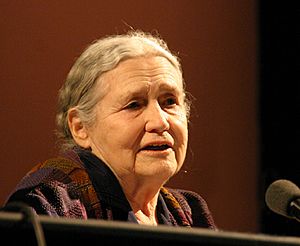
Salman Rushdie is among several post-Second World War writers from former British colonies who settled permanently in Britain. Rushdie became famous with Midnight's Children (1981).
Doris Lessing from Southern Rhodesia (now Zimbabwe) published her first novel The Grass is Singing in 1950, after moving to England. She initially wrote about her African experiences. Lessing soon became a dominant presence in English literature, publishing frequently, and won the Nobel Prize for Literature in 2007. V. S. Naipaul (1932–2018) was another immigrant, born in Trinidad, who won the Nobel Prize in Literature. Also from the West Indies is George Lamming (1927–2022), who wrote In the Castle of My Skin (1953). From Pakistan came Hanif Kureshi (1954–), a playwright, screenwriter, filmmaker, novelist, and short story writer. The 2017 Nobel Prize winner Kazuo Ishiguro (1954–) was born in Japan, but his parents moved to Britain when he was six, and he became a British citizen as an adult. Martin Amis (1949) is one of the most prominent British novelists of the late 20th and early 21st centuries. Pat Barker (1943–) has won many awards for her fiction. English novelist and screenwriter Ian McEwan (1948–) is a highly regarded writer.
Drama
An important cultural movement in British theater that developed in the late 1950s and early 1960s was Kitchen sink realism (or "kitchen sink drama"). This style of social realism showed the home lives of the working class to explore social and political issues. The polite "drawing room" plays of the post-war period, typical of dramatists like Sir Terence Rattigan and Sir Noël Coward, were challenged in the 1950s by these "angry young men" in plays like John Osborne's Look Back in Anger (1956).
Also in the 1950s, the Theatre of the Absurd greatly influenced British dramatists, especially with Irishman Samuel Beckett's play Waiting for Godot. Among those influenced were Harold Pinter (1930–2008), known for The Birthday Party (1958), and Tom Stoppard (1937–), known for Rosencrantz and Guildenstern are Dead (1966).
The Theatres Act 1968 ended the system of stage censorship that had existed in Great Britain since 1737. The new freedoms of the London stage were tested by Howard Brenton's The Romans in Britain, first staged at the National Theatre in 1980.
Other playwrights whose careers began later in the century include: Sir Alan Ayckbourn (Absurd Person Singular, 1972), Michael Frayn (1933–), playwright and novelist, David Hare (1947–), and David Edgar (1948–). Dennis Potter's most distinctive dramatic work was produced for television.
During the 1950s and 1960s, many major British playwrights either started their careers with the BBC or had their works adapted for radio. Many major British playwrights, in fact, either effectively began their careers with the BBC, or had works adapted for radio, including Caryl Churchill and Tom Stoppard whose "first professional production was in the fifteen-minute Just Before Midnight programme on BBC Radio, which showcased new dramatists". John Mortimer made his radio debut as a dramatist in 1955, with his adaptation of his own novel Like Men Betrayed for the BBC Light Programme. Other notable radio dramatists included Brendan Behan, from Ireland, and novelist Angela Carter.
Among the most famous works created for radio are Dylan Thomas's Under Milk Wood (1954), Samuel Beckett's All That Fall (1957), Harold Pinter's A Slight Ache (1959), and Robert Bolt's A Man for All Seasons (1954).
Poetry
While poets T. S. Eliot, W. H. Auden, and Dylan Thomas were still publishing after 1945, new poets started their careers in the 1950s and 1960s. These included Philip Larkin (1922–85), known for The Whitsun Weddings (1964), and Ted Hughes (1930–98), known for The Hawk in the Rain (1957). Northern Ireland has produced many important poets, the most famous being Nobel Prize winner Seamus Heaney. However, Heaney considered himself Irish, not British. Other poets from Northern Ireland include Derek Mahon, Paul Muldoon, James Fenton, Michael Longley, and Medbh McGuckian.
In the 1960s and 1970s, Martian poetry aimed to make ordinary things seem new and strange, as if seen through the eyes of a Martian. Poets most linked to this style are Craig Raine and Christopher Reid. Martin Amis, an important novelist, also tried to make the familiar strange in his fiction. Another literary movement was the British Poetry Revival, which included performance poetry, sound poetry, and concrete poetry. Leading poets in this movement include J. H. Prynne, Eric Mottram, Tom Raworth, Denise Riley, and Lee Harwood. It was a reaction against a more traditional group called "The Movement".
The Liverpool poets were Adrian Henri, Brian Patten, and Roger McGough. Their work was a deliberate attempt to create an English version of the Beat Generation poets. Tony Harrison (1937–) explores language and the tension between his native dialect (working-class Leeds) and learned language. Simon Armitage is another notable poet.
Geoffrey Hill (1932–2016) has been considered among the most distinguished English poets of his generation. Charles Tomlinson (1927–2015) is another important English poet of an older generation. Although "since his first publication in 1951, he has gained more recognition internationally than in his home country, England."
Scottish Literature
In the late 20th century, Scotland produced several important novelists. These include James Kelman, who, like Samuel Beckett, can find humor in grim situations. A. L. Kennedy's 2007 novel Day was named Book of the Year in the Costa Book Awards. Alasdair Gray's Lanark: A Life in Four Books (1981) is a dystopian fantasy set in his hometown of Glasgow.
Highly Anglicized (more English-like) Lowland Scots is often used in modern Scottish fiction. For example, the Edinburgh dialect of Lowland Scots is used in Trainspotting by Irvine Welsh to show a harsh picture of working-class Edinburgh drug users. In Northern Ireland, James Fenton's poetry is written in modern Ulster Scots. The poet Michael Longley (born 1939) has experimented with Ulster Scots for translating classical verse, as in his 1995 collection The Ghost Orchid.
Genre Fiction
Early 20th-Century Genre Fiction
Important writers in this genre in the early 20th century included Erskine Childers' The Riddle of the Sands (1903), who wrote spy novels. Emma Orczy (Baroness Orczy) wrote The Scarlet Pimpernel, a historical romance about an English gentleman's adventures during the French Revolution. The main character created the idea of a "hero with a secret identity" in popular culture. John Buchan wrote adventure novels like Prester John (1910). Novels featuring a gentleman adventurer were popular between the wars, like the series by H. C. McNeile with Bulldog Drummond (1920), and Leslie Charteris, whose many books told the adventures of Simon Templar, also known as The Saint.
The medieval scholar M. R. James wrote highly regarded ghost stories set in modern times.
This period was called 'the Golden Age of Detective Fiction'. Agatha Christie, a writer of crime novels, short stories, and plays, is best remembered for her 80 detective novels and successful West End plays. Other female writers called "Queens of crime" include Dorothy L. Sayers (known for her gentleman detective, Lord Peter Wimsey), Margery Allingham (Albert Campion), and New Zealander Ngaio Marsh (Roderick Alleyn). Georgette Heyer created the historical romance genre and also wrote detective fiction.
A major science fiction work from the early 20th century is A Voyage to Arcturus by Scottish writer David Lindsay, first published in 1920. It was a key influence on C. S. Lewis's Space Trilogy.
From the early 1930s to the late 1940s, an informal discussion group linked to the English faculty at the University of Oxford was called The Inklings. Its leading members were the major fantasy novelists J. R. R. Tolkien and C.S. Lewis. Lewis is known for The Screwtape Letters (1942), The Chronicles of Narnia, and The Space Trilogy. Tolkien is best known as the author of The Hobbit (1937), The Lord of the Rings, and The Silmarillion.
Later 20th-Century Genre Fiction
Among important writers of genre fiction in the second half of the 20th century is thriller writer Ian Fleming, creator of James Bond 007. Fleming wrote about Bond's adventures in twelve novels, including Casino Royale (1953).
In contrast to Bond's larger-than-life spy adventures, John le Carré wrote spy novels that showed a shadowy world of espionage. His best-known novel, The Spy Who Came in from the Cold (1963), is often considered one of the greatest in the genre.
Frederick Forsyth writes thriller novels, and Ken Follett writes spy thrillers as well as historical novels, notably The Pillars of the Earth (1989).
War novels include Alistair MacLean's thrillers The Guns of Navarone (1957) and Where Eagles Dare (1968), and Jack Higgins' The Eagle Has Landed (1975). Patrick O'Brian's nautical historical novels feature the Aubrey–Maturin series set in the Royal Navy.
Ronald Welch's Carnegie Medal-winning novel Knight Crusader is set in the 12th century and describes the Third Crusade, featuring the Christian leader and King of England Richard the Lionheart. Nigel Tranter also wrote historical novels about famous Scottish warriors, like Robert the Bruce in The Bruce Trilogy.
The murder mysteries of both Ruth Rendell and P. D. James are popular crime fiction.
Science Fiction
John Wyndham wrote post-apocalyptic science fiction. His most notable works are The Day of the Triffids (1951) and The Midwich Cuckoos (1957). Other important writers in this genre are Arthur C. Clarke (2001: A Space Odyssey), Brian Aldiss, and Michael Moorcock. Moorcock was involved with the 'New Wave' of science fiction writers who aimed to give the genre more literary value. Similarly, J. G. Ballard (1930–2009) "became known in the 1960s as the most prominent of the 'New Wave' science fiction writers." A later major figure in science fiction was Iain M. Banks, who created a fictional anarchist, socialist, and utopian society called the Culture. Nobel Prize winner Doris Lessing also published a series of five science fiction novels, the Canopus in Argos: Archives, between 1979 and 1983.
Fantasy
Terry Pratchett is best known for his Discworld series of comic fantasy novels, which begins with The Colour of Magic (1983) and includes Night Watch (2002). Philip Pullman is famous for his fantasy trilogy His Dark Materials, which follows two children as they travel through parallel universes during epic events. Neil Gaiman writes both science fiction and fantasy, including Stardust (1998). Douglas Adams is known for his five-volume science fiction comedy series The Hitchhiker's Guide to the Galaxy. J.R.R Tolkien, arguably the most well-known 20th-century Fantasy author, is responsible for the creation of The Lord of the Rings (1954) and the wider Tolkien Legendarium.
20th-Century Literature for Children and Young Adults
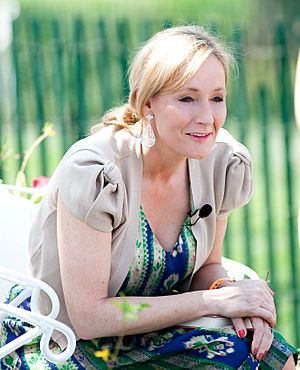
Important writers of works for children include: Kenneth Grahame, known for The Wind in the Willows (1908); Rev W Awdry, for The Railway Series (1945–2011); A. A. Milne, for Winnie-the-Pooh (1926); and P. L. Travers' Mary Poppins. Prolific children's author Enid Blyton wrote about the adventures of a group of young children and their dog in The Famous Five. T. H. White wrote the Arthurian fantasy The Once and Future King, with the first part being The Sword in the Stone (1938). Mary Norton wrote The Borrowers, featuring tiny people who borrow from humans. The inspiration for Frances Hodgson Burnett's novel The Secret Garden was the Great Maytham Hall Garden in Kent. Hugh Lofting created the character Doctor Dolittle, who appears in a series of twelve books. Dodie Smith's The Hundred and One Dalmatians featured the villainous Cruella de Vil.
Roald Dahl is a prominent author of children's fantasy novels, like Charlie and the Chocolate Factory (1964). His stories are often inspired by his childhood experiences, with unexpected endings and dark humor. Popular school stories from this period include Ronald Searle's St Trinian's.
J. K. Rowling's Harry Potter fantasy series is a sequence of seven novels that tell the adventures of the teenage wizard Harry Potter. It is the best-selling book series in history. The series has been translated into 67 languages, making Rowling one of the most translated authors ever. Cressida Cowell wrote How to Train Your Dragon, a series of twelve books set in a fictional Viking world.
21st-Century Literature
Novel
In the 21st century, there has been a strong interest in historical fiction. Hilary Mantel (1952–2022) was a very successful writer of historical novels, winning the Booker Prize twice for Wolf Hall (2009) and Bring Up the Bodies. One of the more ambitious novelists to emerge in this period is David Mitchell, whose wide-ranging novel Cloud Atlas (2004) spans from the 19th century into the future. Influences from earlier literary styles and techniques in English literature are notable in writers like Ian McEwan in his 2002 novel Atonement. Zadie Smith was praised for her first novel White Teeth (2000) and for her later novels. Julian Barnes (1946–) is another prominent writer who won the 2011 Booker Prize for his book The Sense of an Ending. Kazuo Ishiguro was noted for works like the dystopian science fiction novel Never Let Me Go (2005) and was later awarded the 2017 Nobel Prize in Literature for his novels.
Theatre
The theater landscape has changed, moving from one national theater at the end of the 20th century to four, due to the transfer of cultural policy to different regions.
Literary Institutions
Original literature continues to be promoted by organizations like the Eisteddfod in Wales and the Welsh Books Council. The Royal Society of Edinburgh also includes literature in its activities. Literature Wales is the Welsh national agency for promoting literature and a society for writers. It manages the Wales Book of the Year award. The Eisteddfod tradition in the Channel Islands encouraged poetry recitation and performance, a tradition that continues today.
Formed in 1949, the Cheltenham Literature Festival is the longest-running festival of its kind in the world. The Hay Festival in Wales attracts wide interest, and the Edinburgh International Book Festival is the largest book festival of its kind globally.
The Poetry Society publishes and promotes poetry, especially through an annual National Poetry Day. World Book Day is celebrated in Britain and the Crown Dependencies on the first Thursday in March each year.
Literary Prizes
British winners of the Nobel Prize in Literature include Rudyard Kipling (1907), John Galsworthy (1932), T. S. Eliot (1948), Bertrand Russell (1950), Winston Churchill (1953), William Golding (1983), V. S. Naipaul (2001), Harold Pinter (2005), Doris Lessing (2007), and Kazuo Ishiguro (2017).
Literary prizes that writers from the United Kingdom can win include:
- Booker Prize
- Commonwealth Writers' Prize
- International Dublin Literary Award
- Carnegie Medal
- Costa Book Awards (formerly the Whitbread Awards)
- Orange Prize for Fiction
- Queen's Gold Medal for Poetry
|
See also
 In Spanish: Literatura británica para niños
In Spanish: Literatura británica para niños
- British Library
- British regional literature
- Early Modern English
- English poetry
- English drama
- English novel
- List of English novelists
- List of English writers
- Literature of Northern Ireland
- List of writers of Northern Ireland
- Scottish literature
- Scottish poetry
- Theatre of Scotland
- Scottish Renaissance
- History of the Scots language
- List of Scottish writers
- Literature of Shetland
- Theatre of the United Kingdom
- Welsh literature in English
- Welsh poetry
- List of Welsh writers
- Theatre of Wales
- Women's writing in English
- Literature of Birmingham


